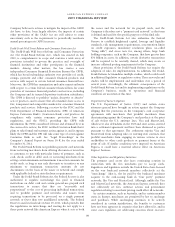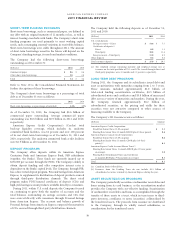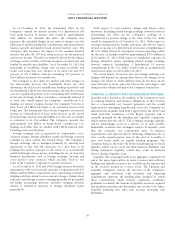American Express 2011 Annual Report Download - page 31
Download and view the complete annual report
Please find page 31 of the 2011 American Express annual report below. You can navigate through the pages in the report by either clicking on the pages listed below, or by using the keyword search tool below to find specific information within the annual report.
AMERICAN EXPRESS COMPANY
2011 FINANCIAL REVIEW
The following provides definitions for capital ratios widely used
in the marketplace, although they may be calculated differently
by different companies:
Tier 1 Common Risk-Based Capital Ratio — The Tier 1 common
risk-based capital ratio is calculated as Tier 1 common equity, a
non-GAAP measure, divided by risk-weighted assets. Tier 1
common equity is calculated by reference to total shareholders’
equity as shown below:
(Millions)
December 31,
2011
Total shareholders’ equity $ 18,794
Effect of certain items in accumulated other comprehensive
income (loss) excluded from Tier 1 common equity 194
Less: Ineligible goodwill and intangible assets (4,051)
Less: Ineligible deferred tax assets (58)
Total Tier 1 common equity $ 14,879
The Company believes the Tier 1 common risk-based capital
ratio may be useful because it can be used to assess and compare
the quality and composition of the Company’s capital with the
capital of other financial services companies. Moreover, the
proposed international banking capital standards known as Basel
III include measures that rely on the Tier 1 common risk-based
capital ratio.
Common Equity and Tangible Common Equity to Risk-Weighted
Assets Ratios — Common equity equals the Company’s
shareholders’ equity of $18.8 billion as of December 31, 2011,
and tangible common equity, a non-GAAP measure, equals
common equity less goodwill and other intangibles of $4.3
billion as of December 31, 2011. The Company believes
presenting the ratio of tangible common equity to risk-weighted
assets is a useful measure of evaluating the strength of the
Company’s capital position.
The Company seeks to maintain capital levels and ratios in
excess of the minimum regulatory requirements; failure to
maintain minimum capital levels could affect the Company’s
status as a financial holding company and cause the respective
regulatory agencies to take actions that could limit the
Company’sbusinessoperations.
The Company’s primary source of equity capital has been the
generation of net income. Historically, capital generated through
net income and other sources, such as the exercise of stock options
by employees, has exceeded the annual growth in its capital
requirements. To the extent capital has exceeded business,
regulatory and rating agency requirements, the Company has
historically returned excess capital to shareholders through its
regular common share dividend and share repurchase program.
The Company maintains certain flexibility to shift capital
across its businesses as appropriate. For example, the Company
may infuse additional capital into subsidiaries to maintain
capital at targeted levels in consideration of debt ratings and
regulatory requirements. These infused amounts can affect the
capital profile and liquidity levels at the American Express’
parent company (Parent Company) level.
SHARE REPURCHASES AND DIVIDENDS
The Company has a share repurchase program to return excess
capital to shareholders. The share repurchases reduce shares
outstanding and offset, in whole or part, the issuance of new
shares as part of employee compensation plans.
During 2011, the Company returned $3.2 billion to its
shareholders in the form of dividends ($856 million) and share
repurchases ($2.3 billion), which represents approximately
56 percent of total capital generated. During the year, the
Company repurchased 48 million common shares at an average
price of $48.13. On January 9, 2012, the Company submitted its
Comprehensive Capital Plan (CCP) to the Federal Reserve
requesting approval to proceed with additional share repurchases
in 2012. The CCP includes an analysis of performance and
capital availability under certain adverse economic assumptions.
The CCP was submitted to the Federal Reserve pursuant to the
Federal Reserve’s guidance on dividends and capital
distributions. The Company expects a response from the Federal
Reserve by March 15, 2012.
Since the inception of repurchase programs in December 1994,
732 million shares have been acquired under cumulative Board
authorizations to repurchase up to 770 million shares. On a
cumulative basis, since 1994, the Company has distributed 63
percent of capital generated through share repurchases and
dividends.
FUNDING STRATEGY
The Company’s principal funding objective is to maintain broad
and well-diversified funding sources to allow it to meet its
maturing obligations, cost-effectively finance current and future
asset growth in its global businesses as well as to maintain a
strong liquidity profile. The diversity of funding sources by type
of debt instrument, by maturity and by investor base, among
other factors, provides additional insulation from the impact of
disruptions in any one type of debt, maturity or investor. The
mix of the Company’s funding in any period will seek to achieve
cost-efficiency consistent with both maintaining diversified
sources and achieving its liquidity objectives. The Company’s
funding strategy and activities are integrated into its asset-
liability management activities. The Company has in place a
Funding Policy covering American Express Company and all of
its subsidiaries.
The Company’s proprietary card businesses are the primary
asset-generating businesses, with significant assets in both
domestic and international cardmember receivable and lending
activities. The Company’s financing needs are in large part a
consequence of its proprietary card-issuing businesses and the
maintenance of a liquidity position to support all of its business
activities, such as merchant payments. The Company generally
pays merchants for card transactions prior to reimbursement by
cardmembers and therefore funds the merchant payments during
the period cardmember loans and receivables are outstanding.
The Company also has additional financing needs associated
with general corporate purposes, including acquisition activities.
29
























